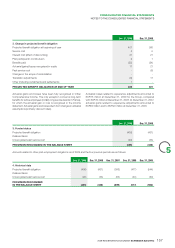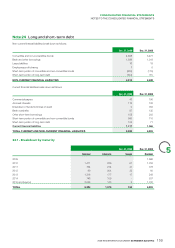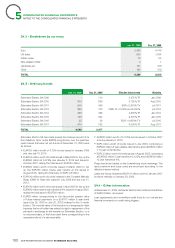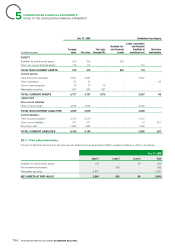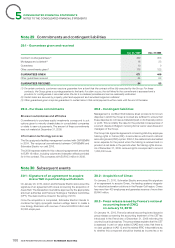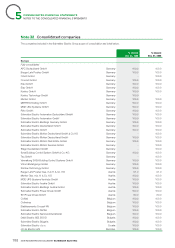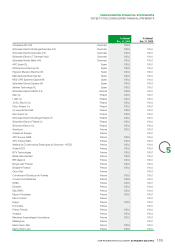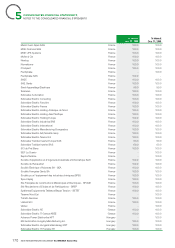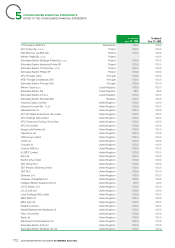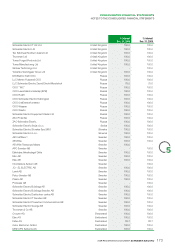APC 2009 Annual Report Download - page 168
Download and view the complete annual report
Please find page 168 of the 2009 APC annual report below. You can navigate through the pages in the report by either clicking on the pages listed below, or by using the keyword search tool below to find specific information within the annual report.
2009 REGISTRATION DOCUMENT SCHNEIDER ELECTRIC166
CONSOLIDATED FINANCIAL STATEMENTS
5NOTES TO THE CONSOLIDATED FINANCIAL STATEMENTS
Note29
Commitments and contingent liabilities
29.1 - Guarantees given and received
Dec. 31, 2009 Dec. 31 2008
Contract counterguarantees (1) 469 303
Mortgages and collateral (2) 16 23
Guarantees 10 0
Other commitments given (3) 176 123
GUARANTEES GIVEN 671 449
Other guarantees received 64 53
GUARANTEES RECEIVED 64 53
(1) On certain contracts, customers require a guarantee from a bank that the contract will be fully executed by the Group. For these
contracts, the Group gives a counterguarantee to the bank. If a claim occurs, the risk linked to the commitment is assessed and a
provision for contingencies is recorded when the risk is considered probable and can be reasonably estimated.
(2) Certain loans are secured by property, plant and equipment and securities lodged as collateral.
(3) Other guarantees given comprise guarantees to certain lessors that rental payments will be made until the end of the lease.
29.2 - Purchase commitments
Shares in subsidiaries and affiliates
Commitments to purchase equity investments correspond to put
options given to minority shareholders in consolidated companies
or relate to earn-out payments. The amount of these commitments
was not material at December 31, 2009.
Information technology services
The Group signed a facilities management contract with CAPGEMINI
in 2004. The reciprocal commitments between CAPGEMINI and
Schneider Electric run until 2016.
The 2009 expense related to this outsourcing agreement amounted
to EUR 119million, including volume and indexation effects provided
for in the contract. This compares with EUR 133million in 2008.
29.3 - Contingent liabilities
Management is confi dent that balance sheet provisions for known
disputes in which the Group is involved are suffi cient to ensure that
these disputes do not have a material impact on its fi nancial position
or profi t. This is notably the case for the potential consequences of
a current dispute in Belgium involving former senior executives and
managers of the Group.
The Group has signed an agreement concerning statutory employee
training rights in France (DIF). In accordance with French national
accounting board (CNC) opinion 2004-F, the related costs are treated
as an expense for the period when the training is received and no
provision is set aside in the periods when the training rights accrue.
As of December 31, 2009, accrued rights corresponded to around
1,200,000 hours.
Note30
Subsequent events
30.1 - Signature of an agreement to acquire
Areva T&D in partnership with Alstom
On January 20, 2010, Alstom and Schneider Electric announced the
signature of an agreement with Areva concerning the acquisition of
Areva T&D. The transaction must still be approved by the appropriate
anti-trust authorities and France’s Holdings & Transfers Committee
(CPT). The deal could be closed in the spring of 2010.
Once the acquisition is completed, Schneider Electric intends to
combine the highly synergistic medium-voltage teams to create a
new Energy Business with revenue of around EUR 4.6billion and
22,000 employees.
30.2 - Acquisition of Cimac
On January 21, 2010, Schneider Electric announced the signature
of an agreement to acquire Cimac, the leading systems integrator
for industrial automation solutions in the Persian Gulf region. Cimac
has more than 400 employees and generates revenue of more than
EUR 40million.
30.3 - Press release issued by France’s national
accounting board (CNC)
on January 14, 2010
On January 14, 2010, France’s national accounting board issued a
press release concerning the accounting treatment of the CET tax
introduced in the French law of December 31, 2009 reforming the
country’s local business tax. The press release explains that the CET
is assessed in part on value added (CVAE) and notes that there is
no clear guidance in IAS12 and the related IFRIC interpretations as
to whether this component should be treated as income tax or an



